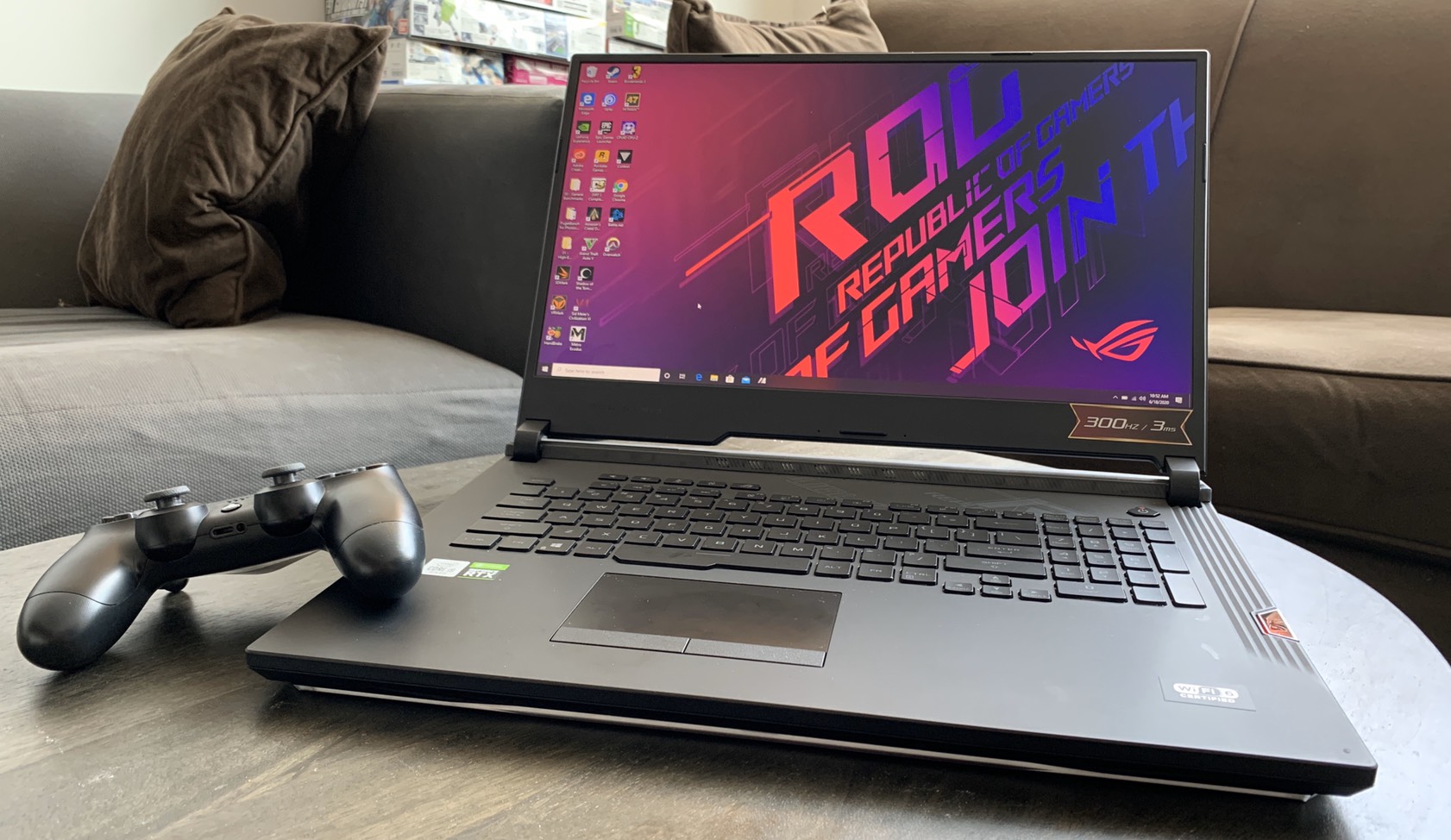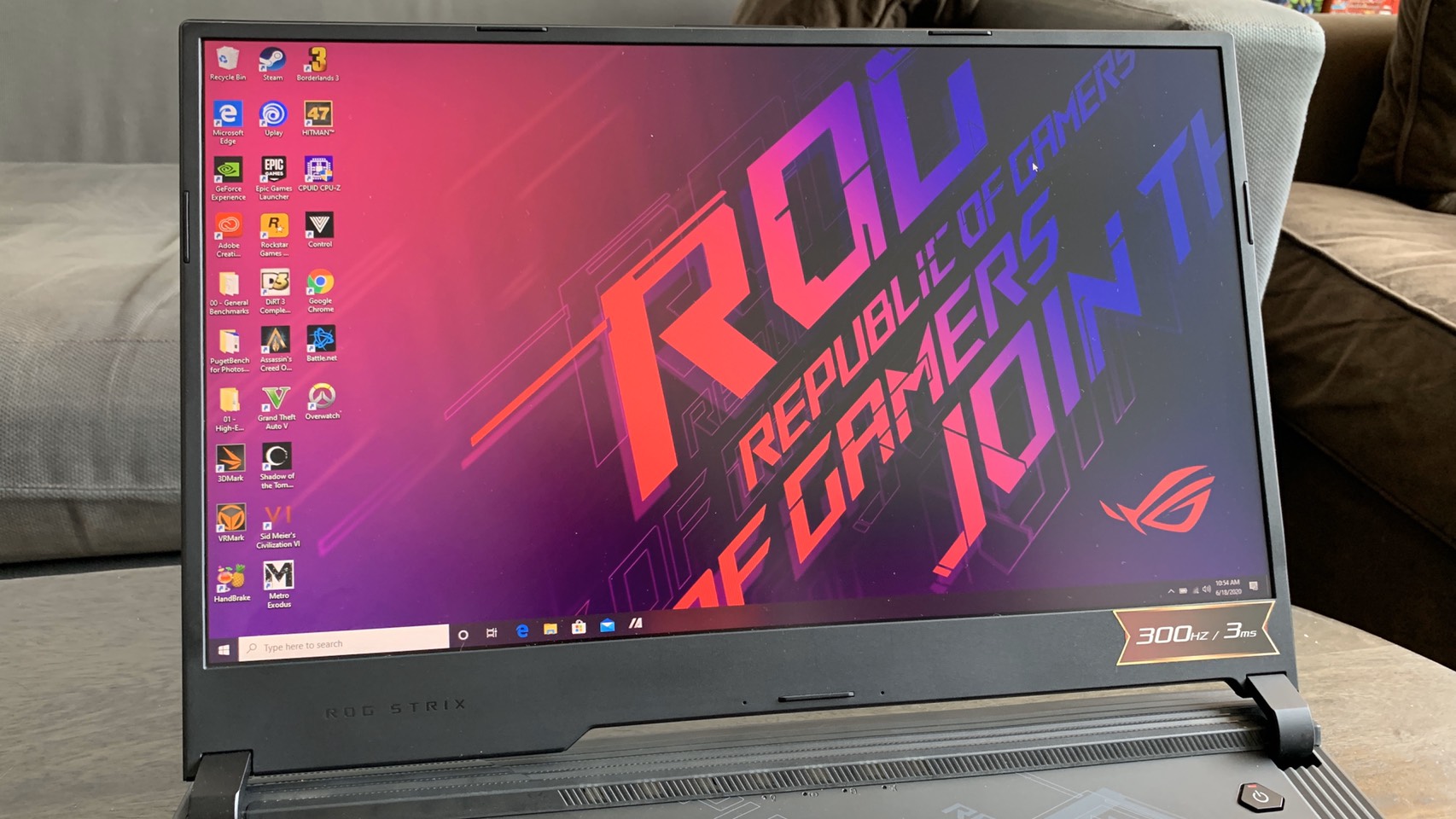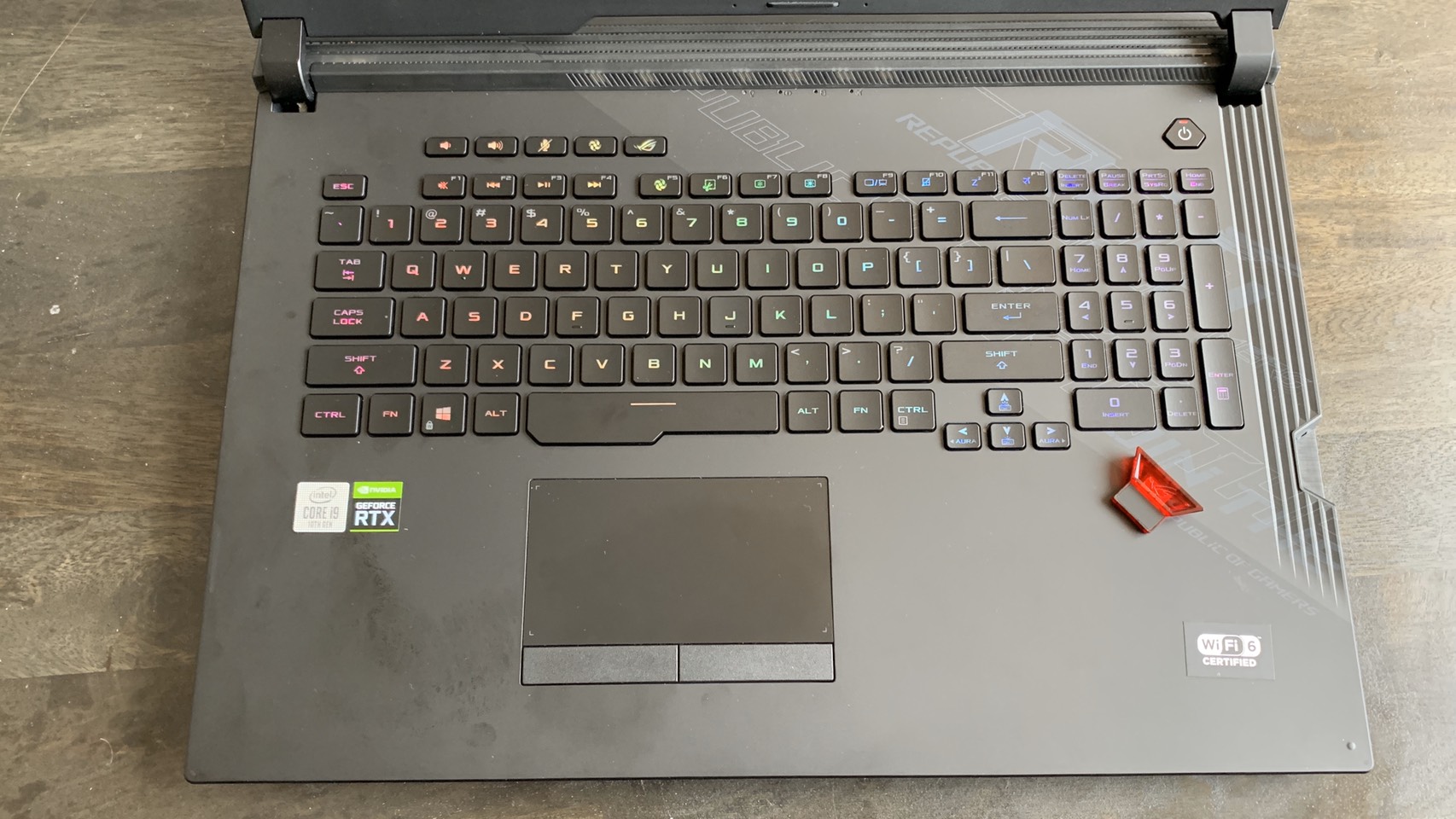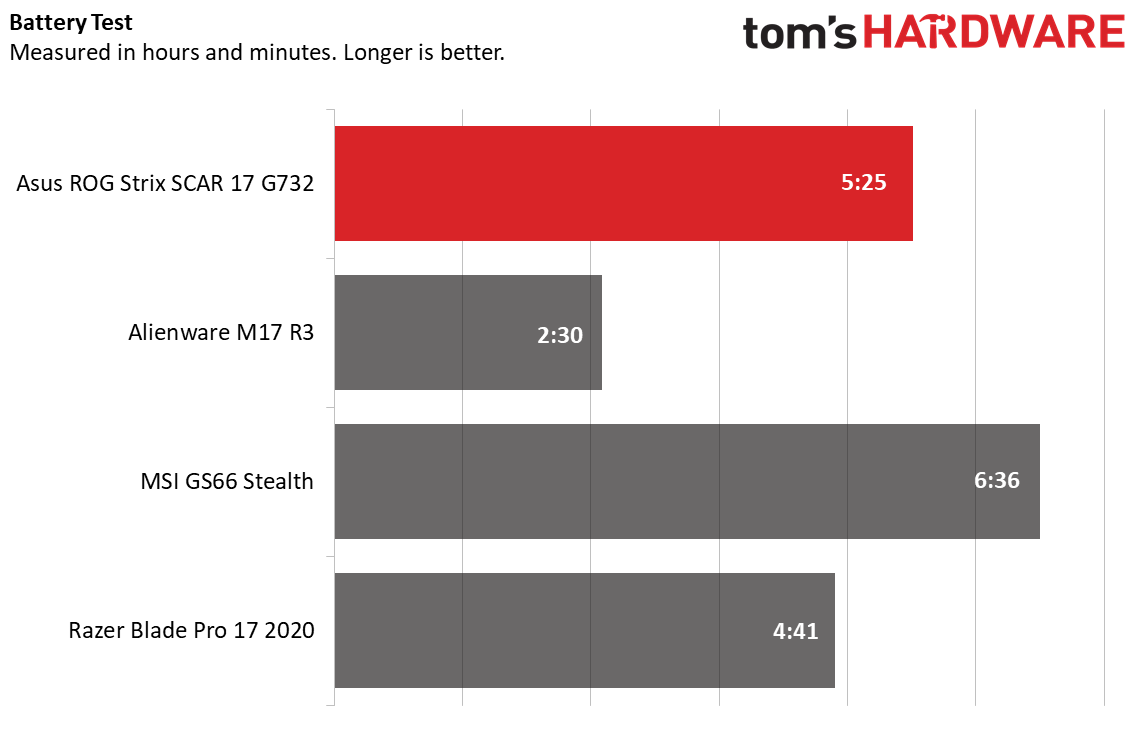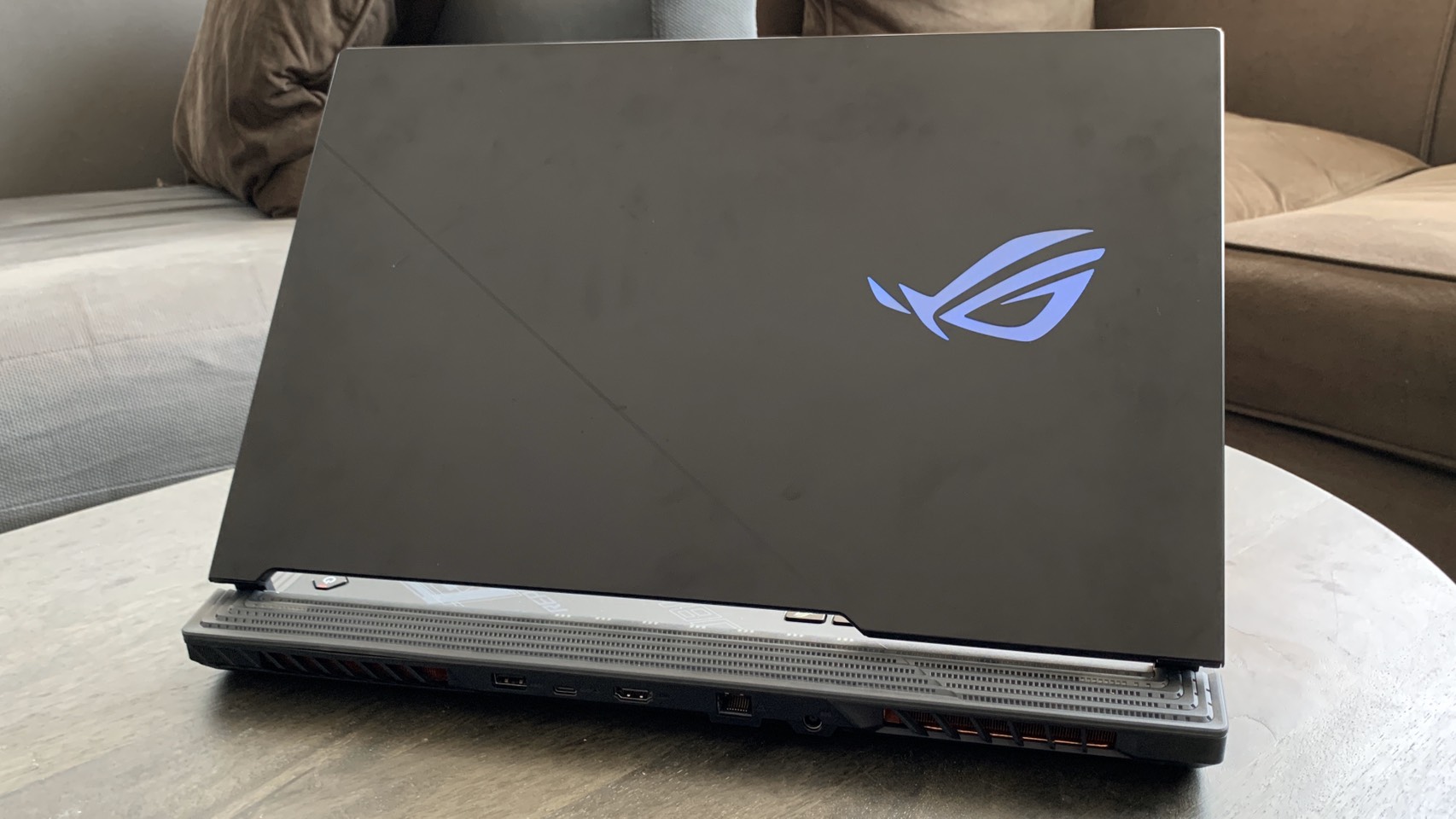Tom's Hardware Verdict
The Asus ROG Strix Scar 17 G732 lives up to its gamer-focused aesthetics with a machine that leverages its specs to achieve more than computers with the same innards, all while displaying at a buttery smooth 300 Hz.
Pros
- +
High refresh rate display
- +
Strong gaming performance
- +
Underside stays cool
Cons
- -
No webcam
- -
Somewhat awkward typing experience
Why you can trust Tom's Hardware
Asus’ ROG Strix Scar 17 G732 ($2,199.99 to start, $3,299.99 as tested) is sold as an esports machine that could give you pro status, and it bolsters that idea with heavy RGB lighting and blaring Republic of Gamers branding. Thankfully, its optional Intel Core i9-10980HK and Nvidia Geforce RTX 2080 Super, both of which sit at the top of their respective product stacks, help the Scar 17 G732 fulfill its promise. The Strix Scar really is the best portable esports machine available right now, assuming you can afford it
The Scar 17 G732 outperformed the similarly specced Alienware m17 R3 at almost every turn, and easily earned itself a place among the best gaming laptops. And with a 300 Hz 17-inch display, the Scar makes sure you can see every frame it pumps out.
Asus ROG Strix Scar 17 G732 Specs
| CPU | Intel Core i9-10980HK |
|---|---|
| Graphics | Nvidia GeForce RTX 2080 Super (8GB GDDR6) |
| Memory | 32GB DDR4 3200 MHz SO-DIMM |
| Storage | 2TB PCIe NVMe M.2 SSD |
| Display | 17.3-inch, 1920 x 1080, 300 Hz |
| Networking | 802.11ax Wi-Fi, Bluetooth 5.0 |
| Ports | 3x USB 3.2 Type-A, 1x USB 3.2 Type C, 1x HDMI 2.0, 1x RJ-45, 1x 3.5 mm Microphone/Headphone jack |
| Camera | No camera |
| Battery | 66 Whr |
| Power Adapter | 240W |
| Operating System | Windows 10 Pro |
| Dimensions(WxDxH) | 15.7 x 11.5 x 1 inches |
| Weight | 6.3 pounds |
| Price (as configured) | $3,299.99 |
Design of ROG Strix Scar 17 G732
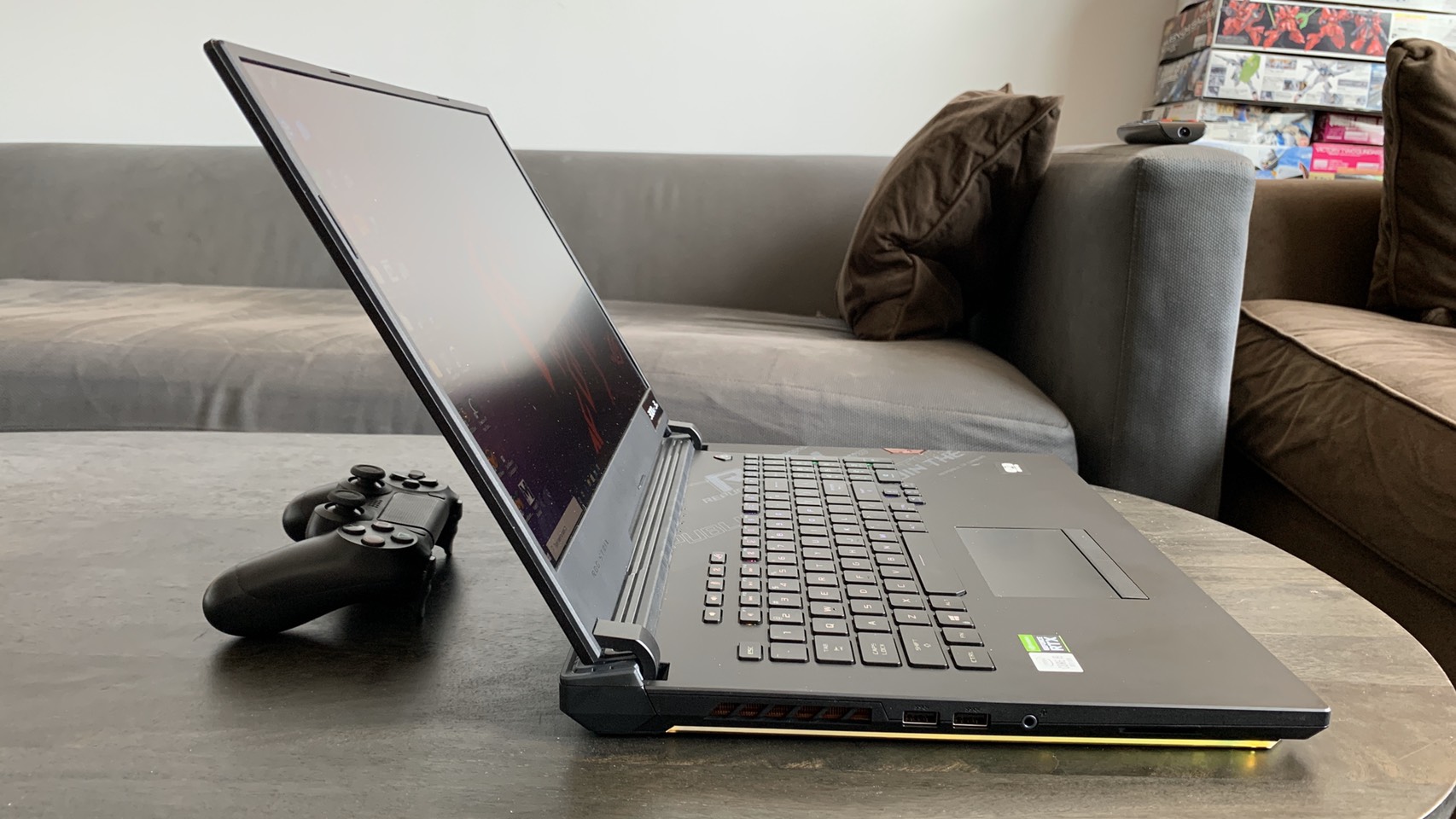
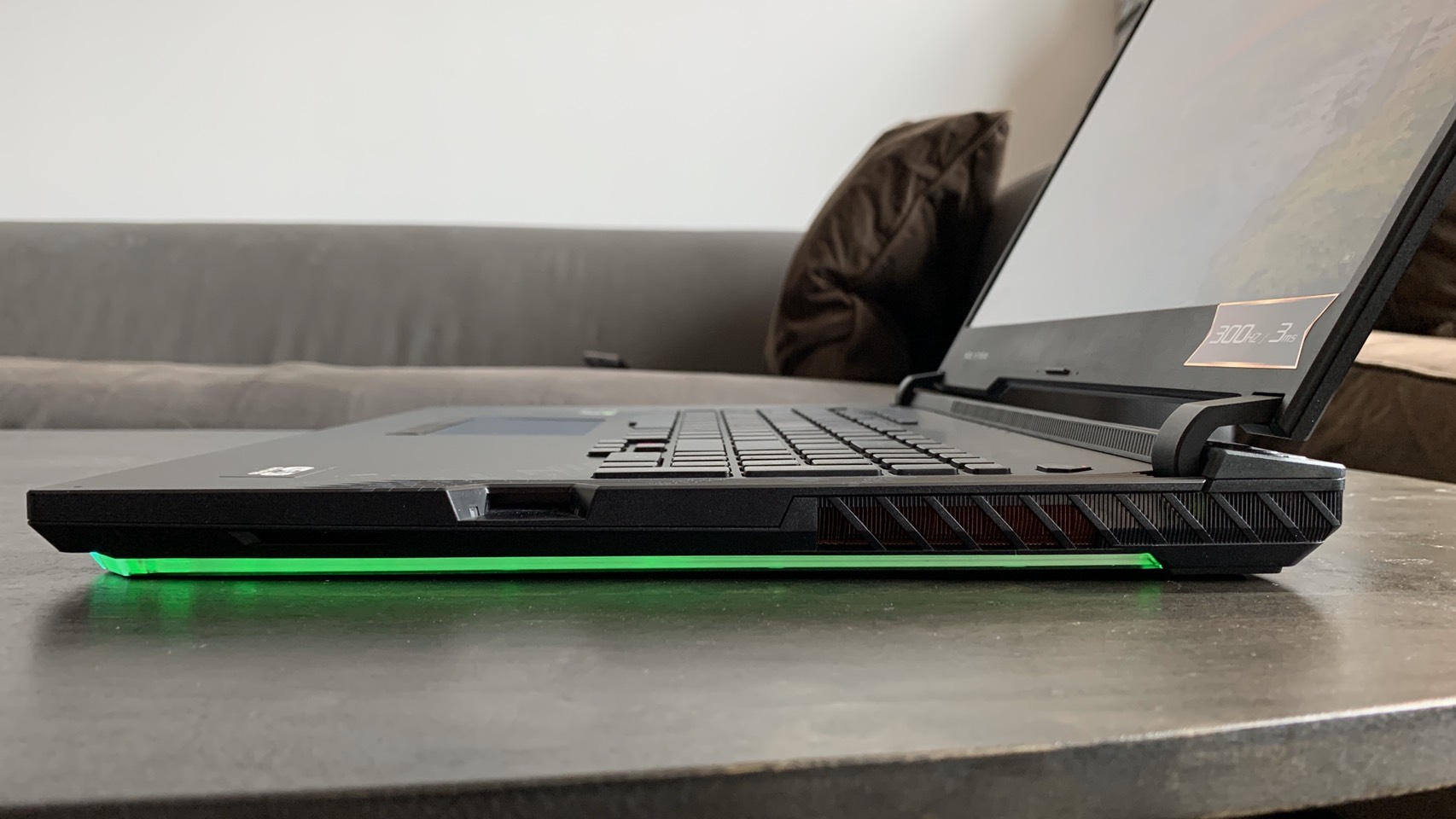


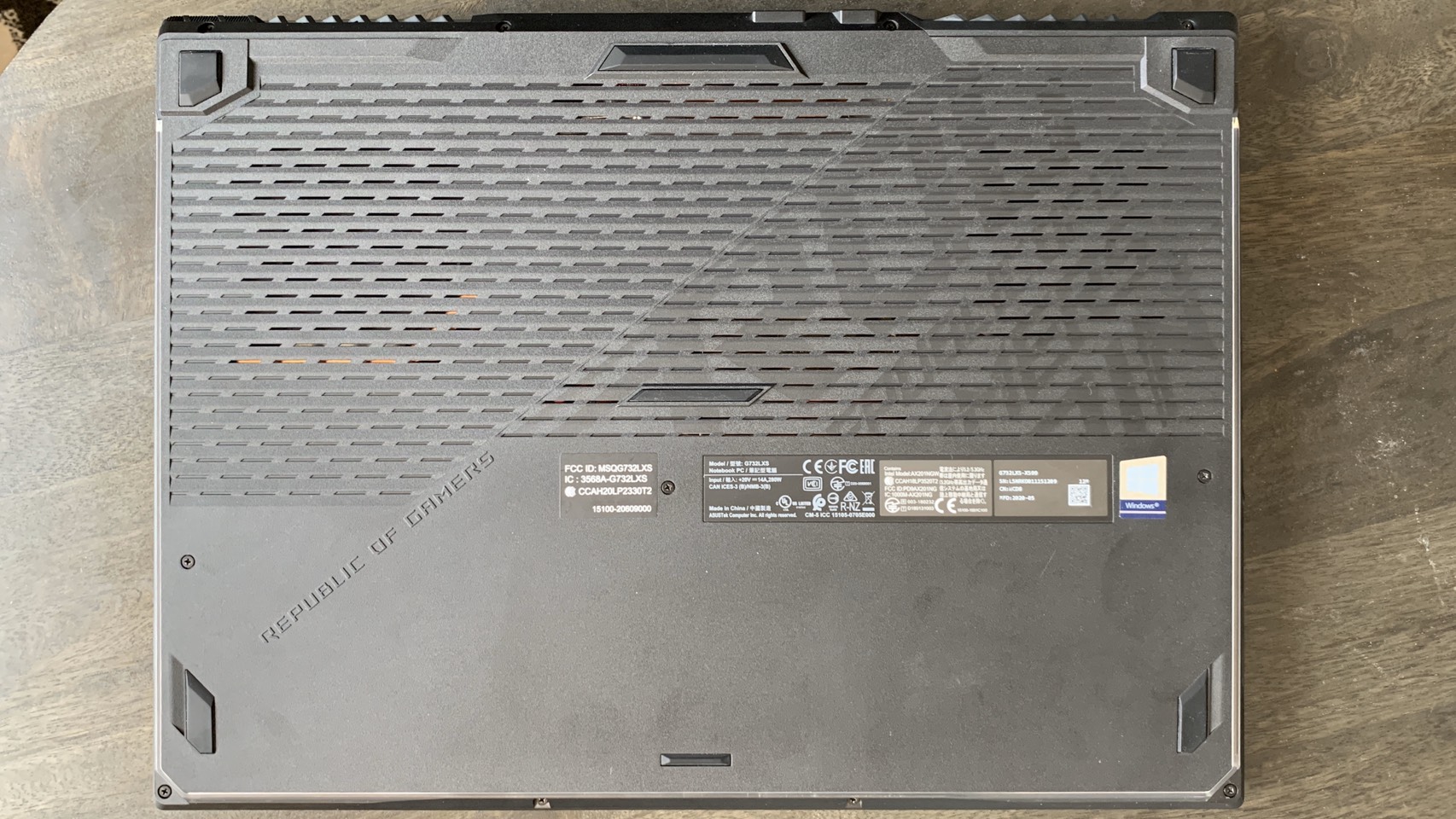
Thanks to their powerful specs, gaming laptops have seen a recent trend of less flashy, more muted designs that allow them to pull double-duty in the office as workstations. That’s not so with the Asus ROG Strix Scar 17 G732. Like its “Republic of Gamers” branding implies, this computer was made inside and out specifically with gaming in mind, and it has the aesthetic to match..
The matte black lid features an LED ROG logo, a glossy diagonal line separating it into two sections and a cutout towards the screen’s hinge to display lights that shows information about sleep mode, charging, disk usage and airplane mode. You can also see just a hint of even more ROG branding on the laptop’s inside through the cutout. The back of the laptop, close to the power outlet but not part of the lid, also has a hard plastic with a nonetheless leathery look and feel on its top half to give it that premium vibe. The back and the sides also show off diagonal fan grills with classy bronze-colored vents inside.
Opening up the laptop reveals its full glory, showing off the per-key RGB chiclet style keyboard, a pattern that repeats “Republic of Gamers” across the keyboard’s right side and more leathery detailing.
There’s also a notch in the right side for the laptop’s “Keystone” feature, which is a small transparent red token with an RFID chip inside that you can attach to the computer to unlock drives that you can set to be hidden if it isn’t inserted.
A programmable RGB light strip also runs across the bottom of the laptop’s front, left and right sides, to provide ambient lighting (Asus includes pack-in armoury crate and aura creator software for adjusting the light strip, the logo on the laptop’s lid and the keyboard).
The Scar’s ports are relegated entirely to the laptop’s left side and back, probably to make way for the Keystone on the computer’s right side. The left side houses two USB 3.2 Type-A ports and one 3.5 mm combination and headphone jack, while the back has one USB 3.2 Type-A port, one USB 3.2 Type-C port, one HDMI 2.0 port, one RJ-45 ethernet port and the DC in.
The back’s Type-C port also supports DisplayPort connections, but not charging. At this price, it would have been nice to see a Thunderbolt 3 port on this laptop.
The Asus ROG Strix Scar 17 G732 is also a bit of a chunky laptop, coming in at 15.7 x 11.05 x 1 inches. That’s not unexpected from a gaming machine, though it is slightly thicker than the Alienware m17 R3’s 15.7 x 11.6 x 0.9 inches.
If you’re looking for slimmer gaming devices, the MSI GS66 Stealth is a more portable 14.2 x 9.7 x 0.7 inches, while the Razer Blade Pro 17 is 15.5 x 10.2 x 0.8 inches.
Gaming Performance of ROG Strix Scar 17 G732
The Asus ROG Strix Scar 17 G732 we reviewed came equipped with an Intel Core i9-10980HK CPU and an Nvidia GeForce RTX 2080 Super. Both of those are in the higher echelon of Intel and Nvidia’s consumer grade gear respectively. The Scar’s two 1TB PCIe M.2 SSDs (connected over RAID0) and 32GB of DDR4 memory were icing on the cake.
I used the Scar to play Control on high settings at 1080p for about a half hour. Depending on the level of activity on screen, my frame rate tended to range between 70 - 90 frames per second, with it normally resting somewhere in the 80s. Thanks to the Scar’s RTX GPU, I was also able to test ray tracing, which dropped my frame rate to a range between 40 - 50 fps when I turned it on with its high preset.
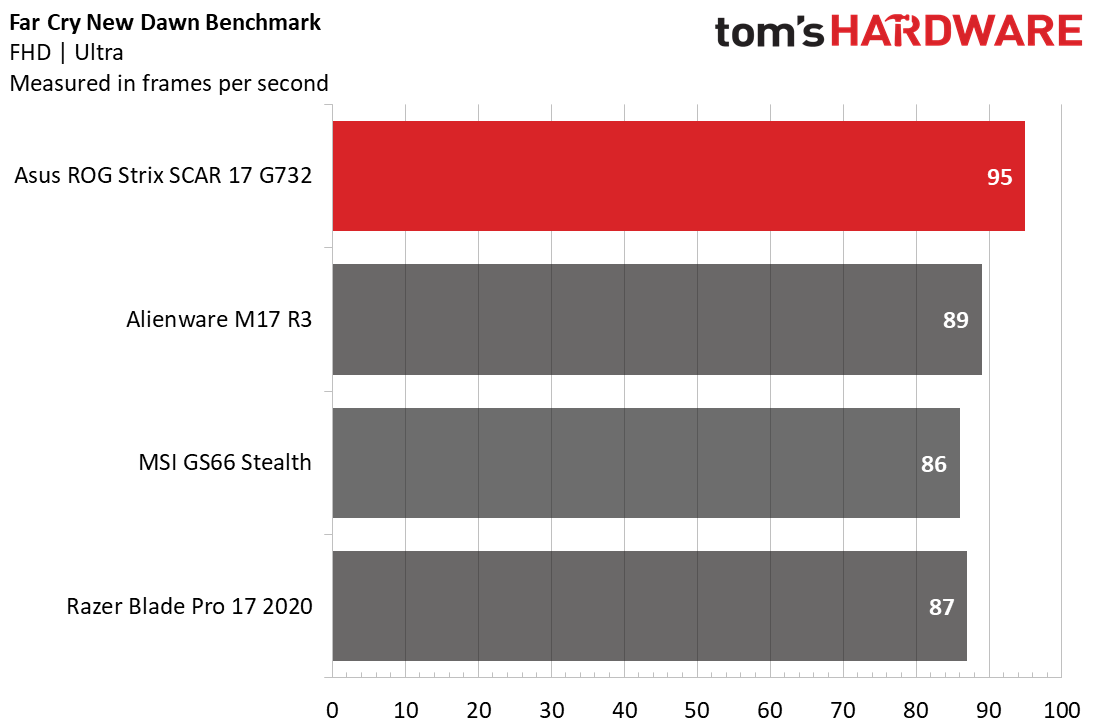
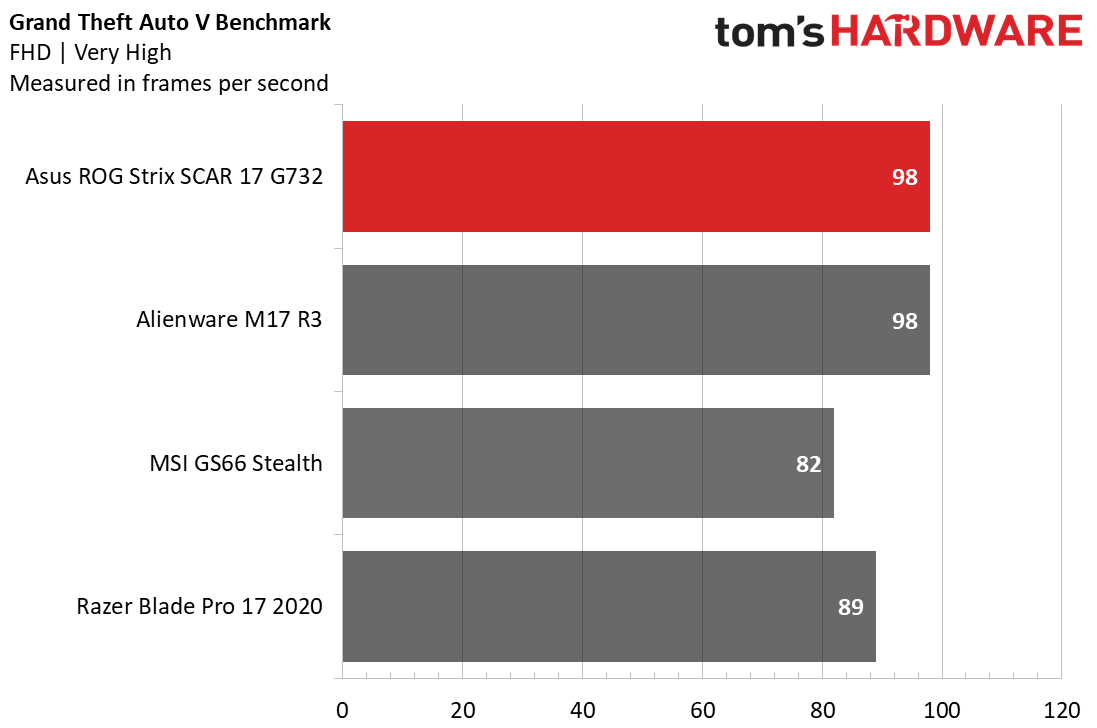
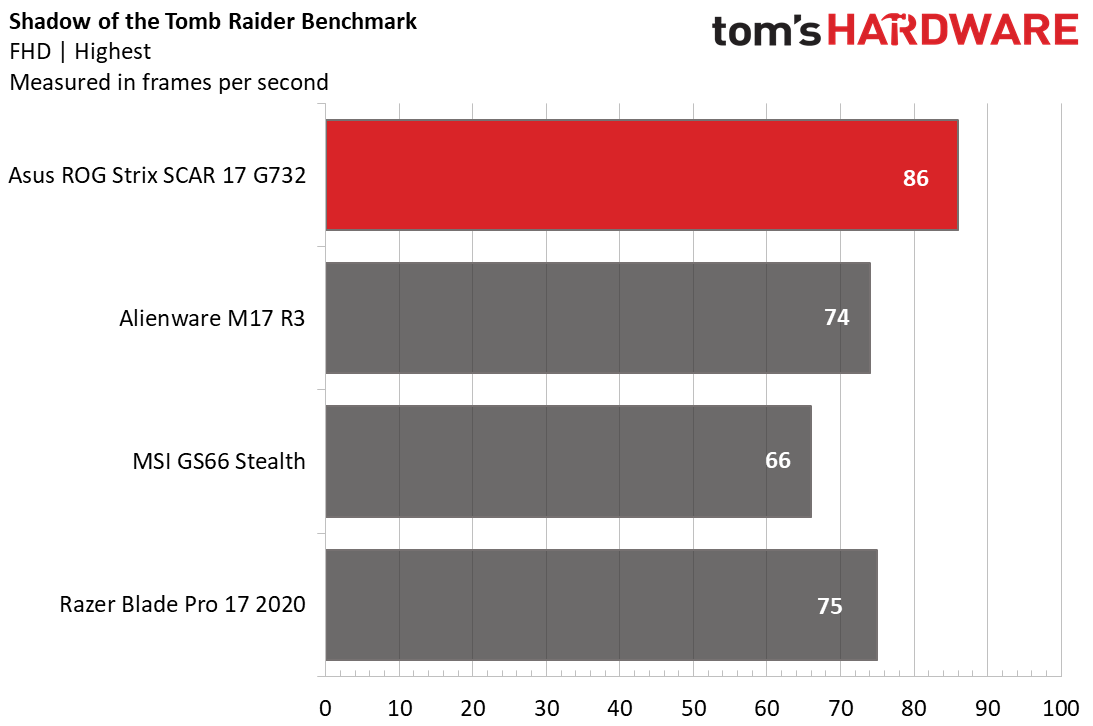
In our benchmarks, the ROG Strix Scar 17 G732's specs also lead to some pretty impressive gaming performance. In our Far Cry: New Dawn (1920 x 1080, ultra) benchmark, for instance, the Scar hit an average frame rate of 95 fps. That’s higher than all of the other competitors we tested, including the Alienware M17 R3 (which comes with the same CPU, GPU and RAM)’s average of 89 fps. Meanwhile, the MSI GS66 Stealth, which has a core i7-10750H CPU, an RTX 2080 Super Max-Q and 32GB of DDR4 RAM hit 86 fps. The Razer Blade Pro 17’s core i7-10875H and RTX 2080 Super Max-Q with 16GB of RAM also hovered around this area, coming in with a score of 87 fps.
Get Tom's Hardware's best news and in-depth reviews, straight to your inbox.
Our Grand Theft Auto V (1920 x 1080, very high) testing showed a similar trend, with the Scar and the Alienware both leading the pack at an average 98 fps. The Stealth earned the lowest score, only hitting an average of 82 fps while the Blade came up in between with an 89 fps average.
The graphically intensive Shadow of the Tomb Raider is perhaps where the Scar was most impressive, though, with Asus’ computer scoring an average 86 fps on its 1920 x 1080 benchmark at its highest preset. That’s 12 fps higher than the Alienware’s 74 fps average, and 20 fps higher than the Stealth’s 66 fps average. The Razer Blade Pro also performed well on this test, though, rising from near the bottom of the pack to hit an average of 75 fps.
We also put the Scar through Metro Exodus’ 1080p RTX benchmark on a loop 15 times to simulate a half hour of gaming. Here, the laptop earned an average of 57.9 fps with an average CPU clock speed of 3.6 GHz and an average GPU clock speed of 1.6 Ghz. It also managed to stay cool, throughout, with the CPU registering an average temperature of 82.7 degrees Celsius (180.9 degrees Fahrenheit) and the GPU hitting a lower average temperature of 79.2 degrees Celsius (174.6 degrees Fahrenheit).
Productivity Performance of ROG Strix Scar 17 G732
Even if it doesn’t exactly look the part, the Asus ROG Strix Scar 17 G732 is still plenty specced out for productivity work.
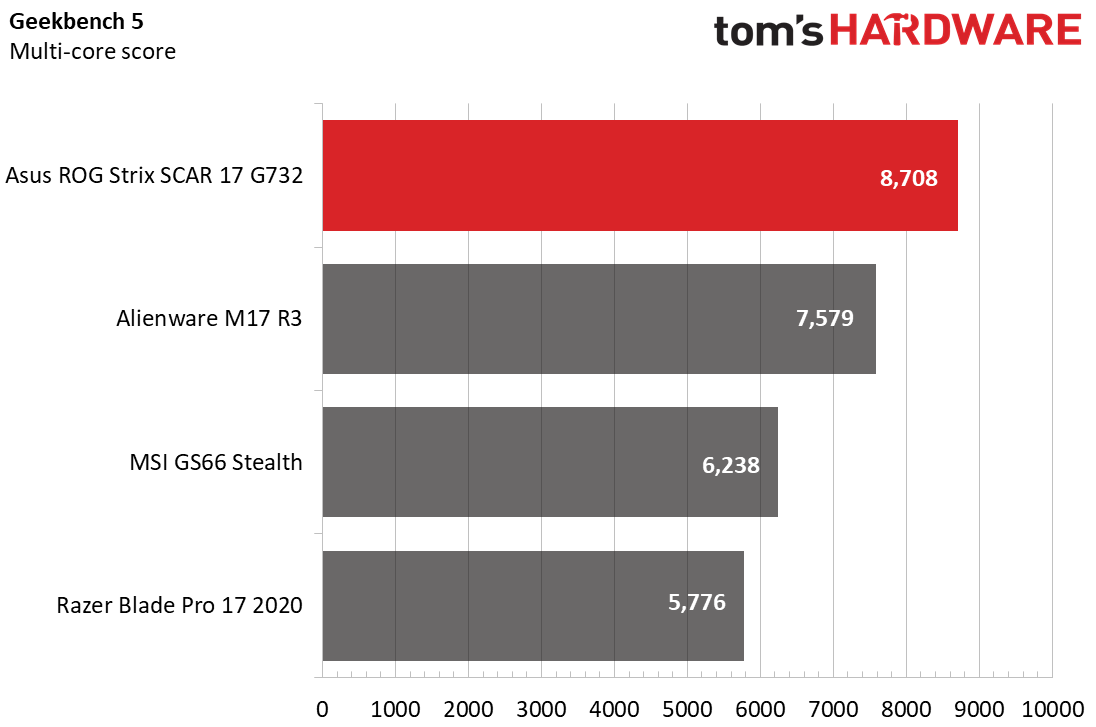


In our Geekbench 5.0 benchmark, the Scar scored 8,708 points, versus the Alienware M17 R3’s 7,579 points, the MSI GS66 Stealth’s 6,238 points and the Razer Blade Pro 17’s 5,776 points. This continues its trend from strong gaming performance into strong productivity performance as well, even among similar competitors.
Our Handbrake video transcoding test, which tracks how long it takes a computer to transcode a video down from 4K resolution (3840 x 2160) to FHD (1920 x 1080), affirmed that the Scar has speed in addition to power. Here, the Scar finished the task in 7 minutes and 6 seconds while the Alienware took 7 minutes and 16 seconds. The MSI GS66 Stealth was the next to finish the task, with a time of 9 minutes and 25 seconds, while the Razer Blade Pro 17 came in last at 9 minutes and 31 seconds.
The only category where the Scar didn’t beat every competitor was in our file transfer test, where we track how long it takes computers to transfer 4.97GB of files. Here, first place actually went to the Stealth, which finished the task in 3 seconds for a speed of 1,694 MBps. The Scar came in second by a few milliseconds, a speed of 1,571 MBps. The Alienware finished transferring the files in 5 seconds or 1,083 MBps, while the Blade completed the transfer in 6 seconds for a rate of 844 MBps.
Display on ROG Strix Scar 17 G732
The Asus ROG Strix Scar 17 G732 emphasizes display speed with a 300Hz 1920 x 1080 screen that has a 3 ms response time. Asus promises that it’s on par with IPS, using the term “vIPS-level” to denote its take on the technology.
Watching the Parasite trailer on the Scar left me feeling about as tense as the movie, though I suspect not for the reasons Asus would like. Viewing angles tended to wash out when looking at the screen from both horizontal and vertical angles over 45 degrees. Colors were accurate, though they didn’t pop. The hues looked a little dull instead. Unfortunately, this came across even worse in dark shots, where blacks had little depth and character silhouettes were difficult to follow.
Playing a game, however, was a different experience. Overwatch at 300Hz is revelatory. 300 fps is the maximum the game will allow, and being able to see all of it means that your character feels buttery smooth. This makes aiming feel easier, but it’s also a treat visually to see every frame Blizzard put into its game’s flashy animations. I thought the 144Hz monitor I use as my daily driver was good, but I honestly don’t know if I can go back.
Our testing largely backed up my experience, with the Scar covering 89% of the DCI-P3 color gamut and hitting an average of 336 nits. That’s a good brightness, but the color coverage isn’t significantly higher than the stealth’s 79% DCI-P3 score or the Blade’s 84% DCI-P3 score.
It also falls well behind the Alienware on both color and brightness, with that machine’s testing showing 117% coverage of the DCI-P3 color gamut and an average 591 nits of brightness. It’s clear that both Alienware and Asus are going for a top-of-the-line visual experience, but while the m17 R3 prioritizes fidelity, the Scar prioritizes high frame rates. For an esports branded machine, that’s definitely the right move.
Keyboard and Touchpad on ROG Strix Scar 17 G732
The Asus ROG Strix Scar 17 G732's keyboard has a lot of features, but typing on it may take some getting used to. The chiclet style keyboard comes with full per-key RGB, includes a numeric keypad and has 5 additional dedicated media buttons along the top-left corner. As expected from a gaming laptop, it’s also got full N-key rollover.
However, I found it awkward that, since the keys are flush with the chassis (no tray), I had to stretch my fingers and raise my wrists more than felt comfortable. It helps, though, that the laptop also has a 4.3-inch long palmrest that provided plenty of space for my wrist.
On 10fastfingers.com, I usually hit between 65 and 72 words per minute, which is below my 75 wpm average. The key feel itself, however, was fine with adequate travel and feedback so others may find the typing experience less awkward than I did.
The Scar’s touchpad, which uses Windows precision drivers, lies to the center left below the keyboard and fills up 4.2 x 2.3 inches of space. This left it out of the way during use, so I didn’t end up accidentally hitting it and throwing off my aim while playing games.
Audio on ROG Strix Scar 17 G732
The Asus Rog Strix Scar 17 G732 has speakers on either side of the case, which means the sound fires away from you. This ended up not impacting my experience much, though, as the laptop was more than loud enough to listen to most songs throughout my entire 2 bedroom apartment once I cranked the volume over 70.
Sound quality was also deep and clear with both low and high notes, as the Scar easily and accurately recreated Queen’s We Will Rock You and A-ha’s Take on Me without almost any information loss. That’s not always an easy task- We Will Rock You’s guitar solo and Take on Me’s chorus can both sound tinny without a good set of speakers, but I’m happy to report that wasn’t the case here. The Scar did have difficulty capturing some of the bassline in We Will Rock You, though that’s not uncommon for audio systems without a dedicated subwoofer.
Upgradeability of ROG Strix Scar 17 G732
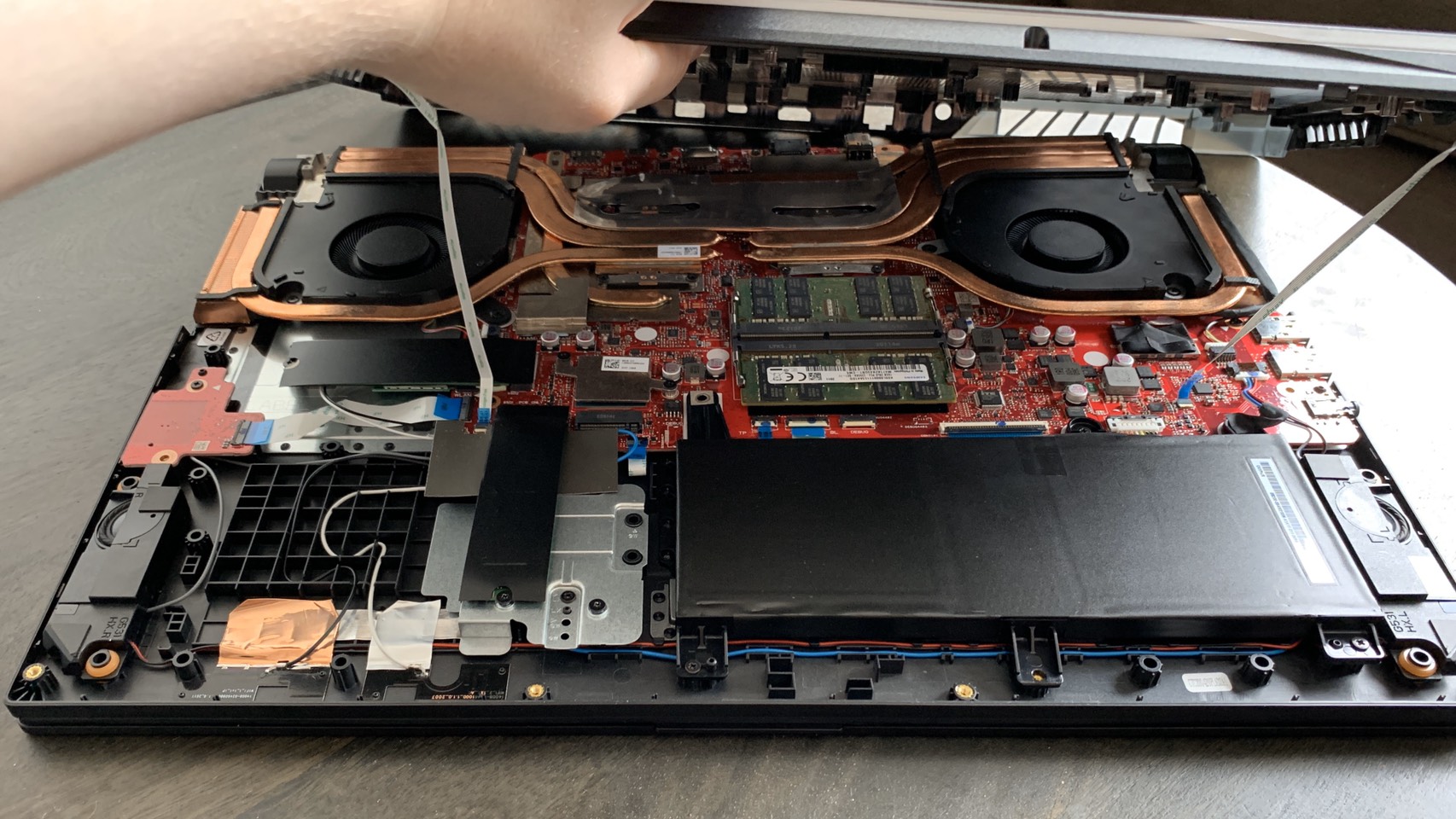
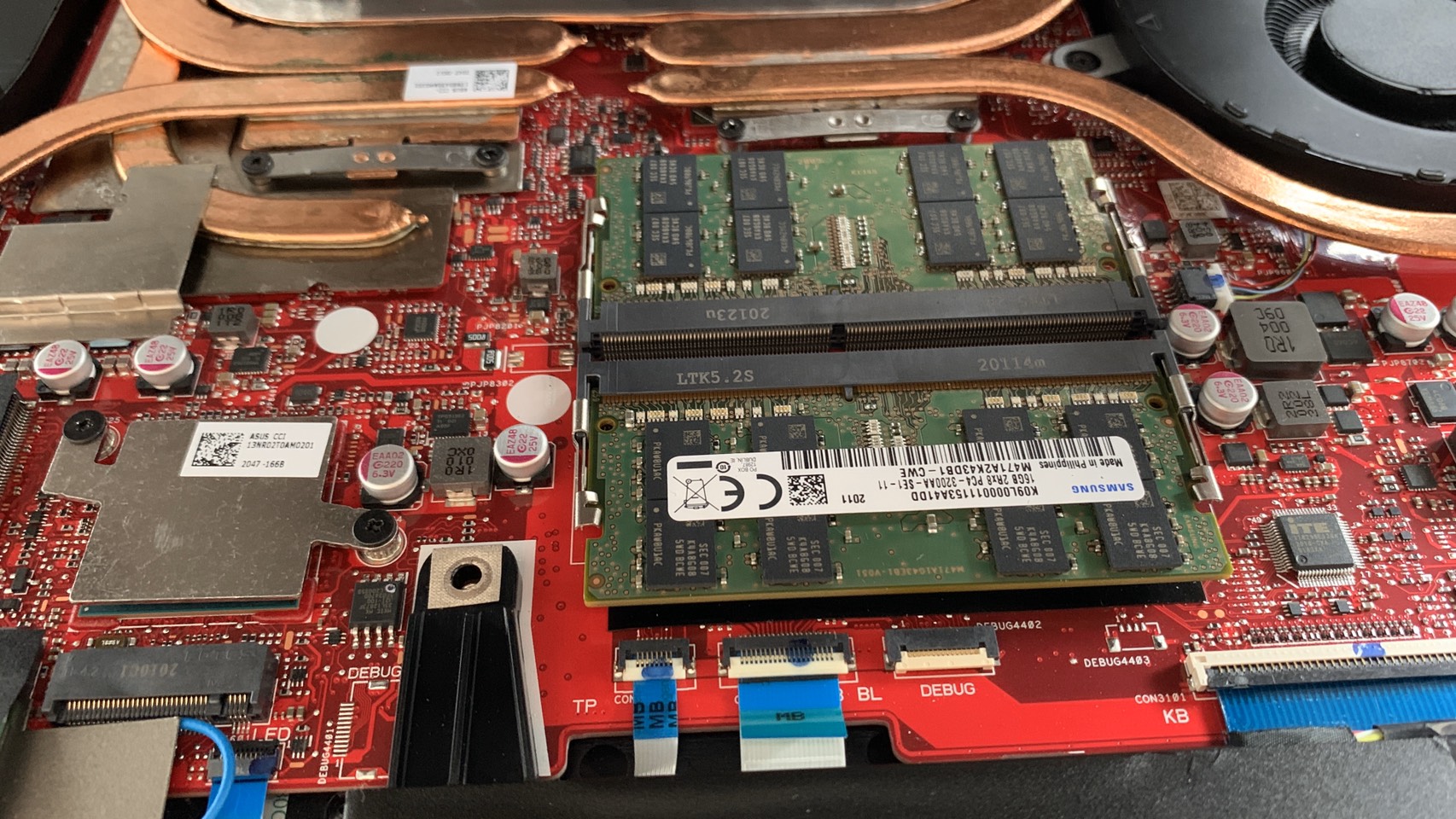
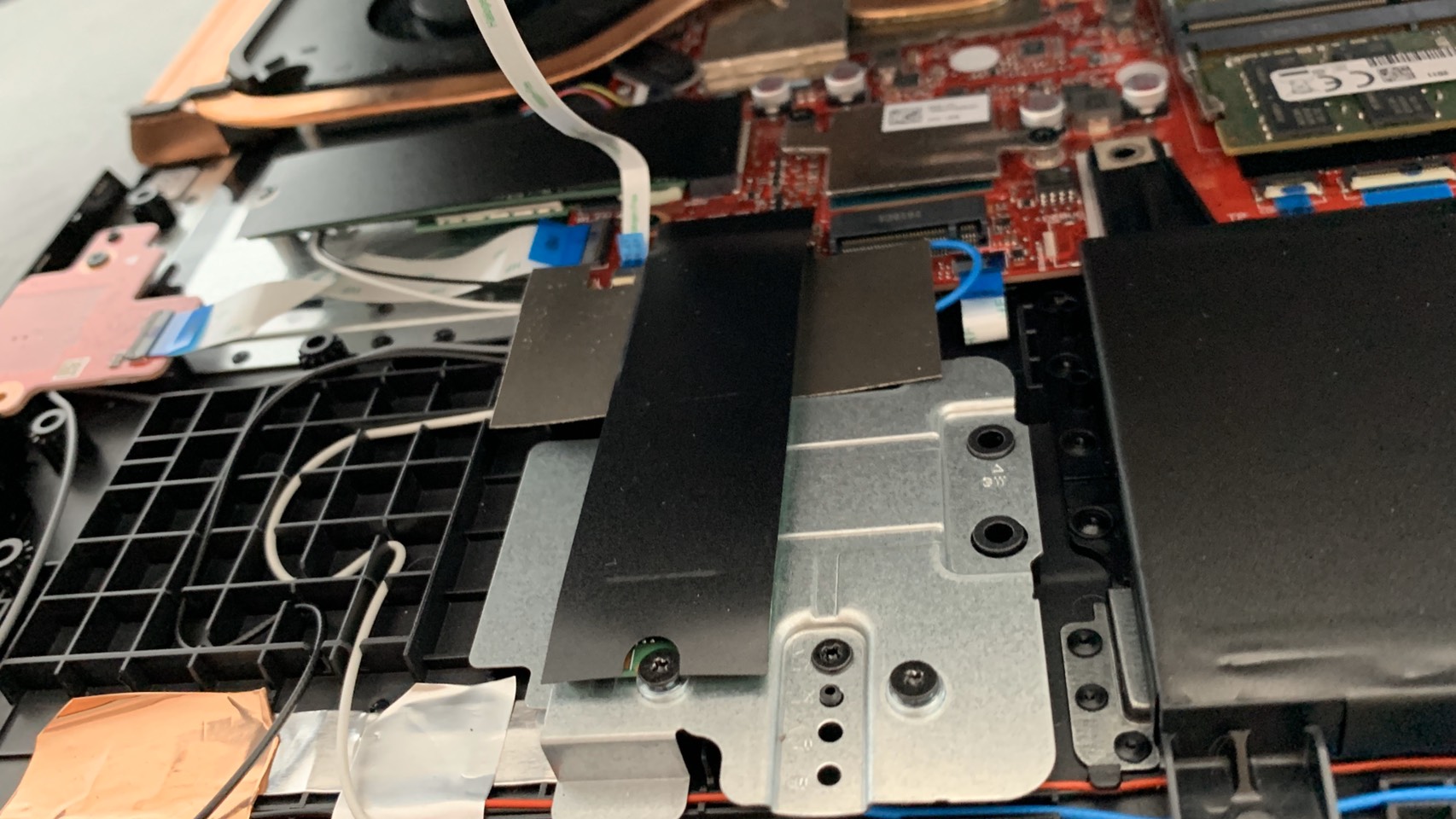
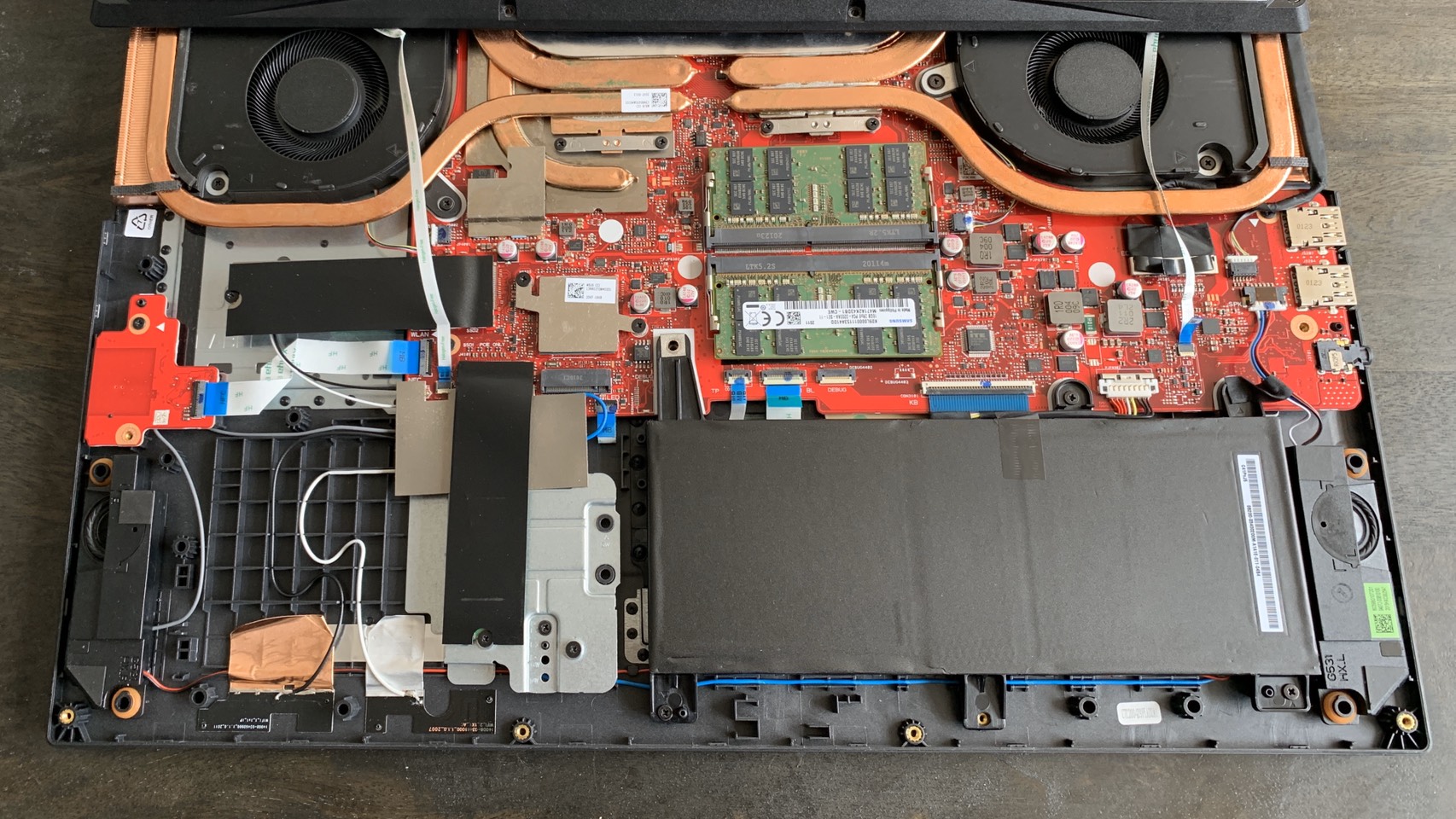
Opening the Asus Rog Strix Scar 17 G732 is a little difficult, thanks to the ribbon cables powering the light panel that runs across the laptop’s front and sides. There’s a pop-up screw in the laptop’s bottom right corner that’s meant to make this easier, but you still have to find the hooks to actually lift the bottom case.
I used a Phillips Head #1 Screwdriver to remove the other 10 screws along the bottom and loosen the pop-up screw and eventually able to carefully lift up the bottom of the case, and reveal the insides. This exposed the RAM, Wi-Fi chip, battery and the two 1TB M.2 SSDs, all of which are replaceable. There’s also a third unoccupied M.2 SSD slot for an additional upgrade down the line. If I were changing out components, I likely would have carefully removed the ribbon cables for easier access.
Battery Life of ROG Strix Scar 17 G732
For a 17-inch gaming laptop with high-end, power sucking components, the ROG Strix Scar 17 G732 actually lasts a fair amount of time on a charge. On our battery test, which continuously browses the web, streams video and runs OpenGL tests at 150 nits, the Scar hung on for 5 hours and 25 minutes.
That’s 3 hours longer than its similarly specced Alienware m17 R3 competitor (which scored 2 hours and 30 minutes, and almost 1 hour longer than the generally slimmerRazer Blade Pro 17 (which scored 4 hours and 41 minutes). The MSI GS66 Stealth did beat the Scar with an uptime of 6 hours and 36 minutes.
Heat on ROG Strix Scar 17 G732
The Asus ROG Strix Scar 17 G732 is surprisingly cool during use, with its main touchpoints being comfortable to touch and the vented air mostly dispersing before hitting my mouse hand.
After streaming a video from YouTube for 15 minutes, the touchpad registered 26.1 degrees Celsius (79 degrees Fahrenheit), while the underside was 31.7 degrees Celsius (89 degrees Fahrenheit). In a bit of an oddity for gaming laptops, the center of the keyboard between the G and H keys was hotter than most of the bottom, hitting 37.2 degrees Celsius (99 degrees Fahrenheit). Still, I didn’t notice it during play. It was also still cooler than the part of the laptop’s bottom closest to the power cable, which registered 53.6 degrees Celsius (128.5 degrees Fahrenheit).
Webcam on ROG Strix Scar 17 G732
The Asus ROG Strix Scar 17 G732 doesn’t come with a webcam, which has become the standard for Asus’ ROG gaming laptops but feels like a lost opportunity as the pandemic forces many workers to continue to telecommute.
Software / Warranty of ROG Strix Scar 17 G732
The Asus ROG Strix Scar 17 G732 comes with a number of gaming-focused programs and utilities.
Chief among these is the Asus Armoury Crate, where users can view computer statistics, select from preset performance and display modes, set custom ones, and adjust certain lighting features. The Asus Aura creator accompanies this, allowing users to create custom RGB profiles across the Scar and connected devices to then assign in Armoury Crate. The customizability here is almost intimidating in its depth, including even an editing timeline for changing effects over time, but lighting nerds will likely appreciate the more advanced toolset.
Sonic Studio III is another Asus app, which lets users adjust their audio to prioritize voice, treble, bass or the like, while also giving them access to an equalizer, noise reduction and other post processing effects for their microphone recordings.
There’s also a customer service and diagnostic tool called MyAsus, which mostly serves as an easy way to troubleshoot issues, update your computer and contact Asus for support.
Finally, Intel Graphics Command Center allows users to quickly adjust their screen’s resolution, refresh rate, brightness, aspect ratio, contrast and other visual elements without needing to dive into Windows.
The Scar is mostly free of bloatware, aside from common Windows pre-installs like Candy Crush Friends and Farm Heroes Saga. Asus has also added McAfee Personal Security to the mix, which is the one big unnecessary addition.
The Scar comes with Asus’ standard one-year limited warranty.
ROG Strix Scar 17 G732 Configurations
Our review unit for the Asus ROG Strix Scar 17 G732 came fully equipped with its most powerful options, including a 10th gen Intel Core i9-10980HK CPU, a full-sized Nvidia GeForce RTX 2080 Super, 32GB of DDR4 memory, two 1TB PCIe M.2 SSDs connected over RAID 0, a 300 Hz display and a 66Whr battery. All of that together totals $3,299.99, but there are other options if you don’t need that kind of power. This version should be available in Q3 of this year.
The Scar 17 starts at $2,199.99, with 10th gen CPU options for both Intel Core i7 and Intel Core i9. On Amazon, all CPU options have access to the same 4 configurations, which are a 144 Hz laptop with a 512GB SSD and RTX 2070, a 240 Hz laptop with a 1TB SSD and RTX 2070, a 300 Hz laptop with a 1TB SSD and RTX 2070 Super and finally our configuration, which is 300 Hz with a 2TB SSD and RTX 2080 Super. When not shopping on Amazon, customization options depend on your retailer.
Specific pricing also seems to vary from retailer to retailer, though $2,699.99 and $2,999.99 seem to be popular prices for configurations that fall in between the starting price and our review unit.
Bottom Line
With its powerful specs, the Asus ROG Strix Scar 17 G732 delivers a professional esports experience. Its 300 Hz screen also makes sure you can see every extra frame that performance snags you, while a surprisingly long battery life and cooling system make it a pleasure to use.
If you want a thinner computer with similar specs, the Alienware m17 R3 will give you comparable though slightly dampened performance, but it will also cost you more if you get its most premium configuration. The MSI GS66 Stealth, meanwhile, is thinner and weaker than both, but also has a 300 Hz screen and is generally less expensive.
But, if you’re willing to go over an inch in thickness and don’t mind a computer that shouts “gamer,” the Scar will give you a premium experience.
Michelle Ehrhardt is an editor at Tom's Hardware. She's been following tech since her family got a Gateway running Windows 95, and is now on her third custom-built system. Her work has been published in publications like Paste, The Atlantic, and Kill Screen, just to name a few. She also holds a master's degree in game design from NYU.
-
TheBizNiz Around 3K for 58 frames on Metro Exodus... Saddens me how price to performance ratio is so egregiously out of key with regards to 'high performance' laptops...Reply -
Sabishii Hito ReplyTheBizNiz said:Around 3K for 58 frames on Metro Exodus... Saddens me how price to performance ratio is so egregiously out of key with regards to 'high performance' laptops...
58fps with RTX enabled.
